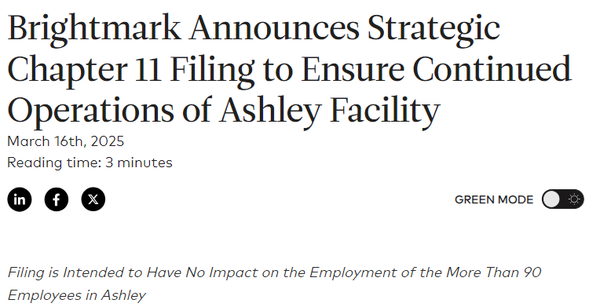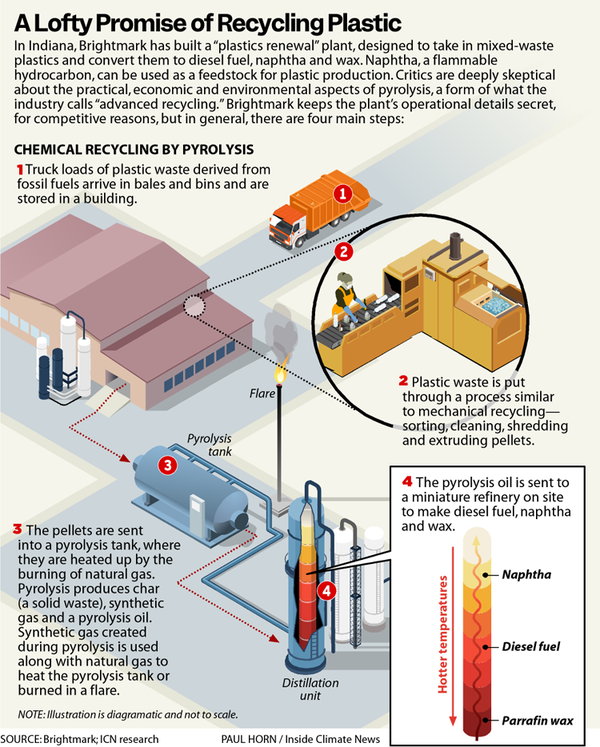Only 5% of capacity in operation! Burdened with debt! Waste plastic pyrolysis plant announces bankruptcy and sale!
Recently, the first chemical recycling plant of Brightmark, an American waste plastic chemical recycling company, in Ashley, Indiana, announced bankruptcy, but Brightmark announced that this will not affect the employment of more than 90 factory employees and will not impact the normal operation of other chemical recycling businesses.
It is reported that the pyrolysis plant sought funding from municipal bond investors six years ago, but due to design flaws and production halts, its capacity was extremely low (5%). Currently, the outstanding municipal debt has reached $170 million (approximately 1.23 billion yuan), with total assets and liabilities between $100 million and $500 million. The sale of the plant is expected to be completed by May 16.

Brightmark's official website announces efforts to ensure the continued operation of the Ashley plant
This bankruptcy filing came two weeks after Brightmark failed to repay a $12.9 million debt owed to UMB Bank, resulting in the bank issuing a default notice.
Court documents show that Brightmark determined last month that a restructuring might be necessary, and the company decided to no longer provide ongoing unsecured financing to the plant, but instead to fund it through loans until the plant can be sold.
early entrants in emerging markets
The Indiana plant project was initially announced by RES Polyflow in 2015. It was originally designed as a plastic-to-fuel plant, which would take in mixed plastics and produce a blend of diesel and gasoline feedstocks. Recently, the company has positioned the plant to process mixed plastics into raw materials for new plastic production.
In 2018, Brightmark Energy acquired a majority stake in RES Polyflow, aiming to bring the technology to a commercial stage.
In 2019, Brightmark raised $260 million in financing for the Indiana plant, including $185 million in green bonds. In the same year, the company began construction of the plant, and by mid-2020, the Indiana plant was operational and began trial runs of materials.
The financing in 2019 came to an end due to recent financial hurdles. The parent company, Brightmark, has been footing all the costs for the plant—court documents show that so far, Brightmark has invested $211 million in the plant, with $44.6 million invested just in 2024.
According to court documents, Brightmark Plastics Renewal reported that its pyrolysis plant in Indiana is "operating at only 5% capacity and unable to generate sufficient revenue to fund" the operation of the plant. The monthly "operations and improvements" costs for the plant are between $3.5 million and $4 million.
Brightmark Indiana Ashley Pyrolysis Plant
Brightmark describes its plant as the "world's largest pyrolysis facility," designed to collect waste plastic shipped from urban and industrial sources. The waste is cleaned, shredded, and pressed into small pellets, which are then fed into pyrolysis tanks and heated through combustion. The synthetic gas produced by the pyrolysis process is mixed with natural gas, generating temperatures of 800 to 1500 degrees Fahrenheit.
Coke is sent to landfills as non-hazardous waste, pyrolysis oil enters a small refinery behind the warehouse, where it is separated into low-sulfur diesel, flammable liquid naphtha, and industrial wax.
Brightmark's early filings with the EPA (Environmental Protection Agency) indicated that the company acknowledged only 20% of the output was the described oil. The majority of the rest, 70%, was syngas that the company claimed generates heat by burning like natural gas, with 20% of the syngas being burned off. According to the documents, the remainder was coke.
The technical challenges troubling the pyrolysis plant can be guessed from the publicly available information in previous years:
These wastes are made up of many different types of plastics and vary by city and season. Some plastics harm the pyrolysis process by introducing oxygen-containing molecules, thus reducing yield and lowering the quality of pyrolysis oil.
2. PVC commonly found in labels, films, and packaging contains chlorine atoms, which can cause equipment corrosion and contaminate pyrolysis oil;
3. Household plastic waste from municipal waste processing facilities is also contaminated by other garbage that disrupts the pyrolysis process, including liquids, food, dirt, paper, glass, metal, and PS foam.

The company revealed last year that as of mid-2024, the plant's annual processing capacity is 200 million pounds, but since its opening four years ago, it has processed a total of 4 million pounds. Even with lower operating rates, the company has been working to expand the capacity of the Indiana plant, which is a "necessary capital-intensive project to make (the plant) financially viable."
All of this adds up to a large amount of ongoing capital costs with little return at present. Meanwhile, Brightmark announced it is developing an additional 950 million dollar, 2.5 million square foot facility in Thomaston, Georgia—Brightmark says the project is not affected by the Indiana bankruptcy filing.
【Copyright and Disclaimer】The above information is collected and organized by PlastMatch. The copyright belongs to the original author. This article is reprinted for the purpose of providing more information, and it does not imply that PlastMatch endorses the views expressed in the article or guarantees its accuracy. If there are any errors in the source attribution or if your legitimate rights have been infringed, please contact us, and we will promptly correct or remove the content. If other media, websites, or individuals use the aforementioned content, they must clearly indicate the original source and origin of the work and assume legal responsibility on their own.
Most Popular
-

List Released! Mexico Announces 50% Tariff On 1,371 China Product Categories
-

Nissan Cuts Production of New Leaf EV in Half Due to Battery Shortage
-

New Breakthrough in Domestic Adiponitrile! Observing the Rise of China's Nylon Industry Chain from Tianchen Qixiang's Production
-

Dow, Wanhua, Huntsman Intensively Raise Prices! Who Controls the Global MDI Prices?
-

Mexico officially imposes tariffs on 1,400 chinese products, with rates up to 50%






